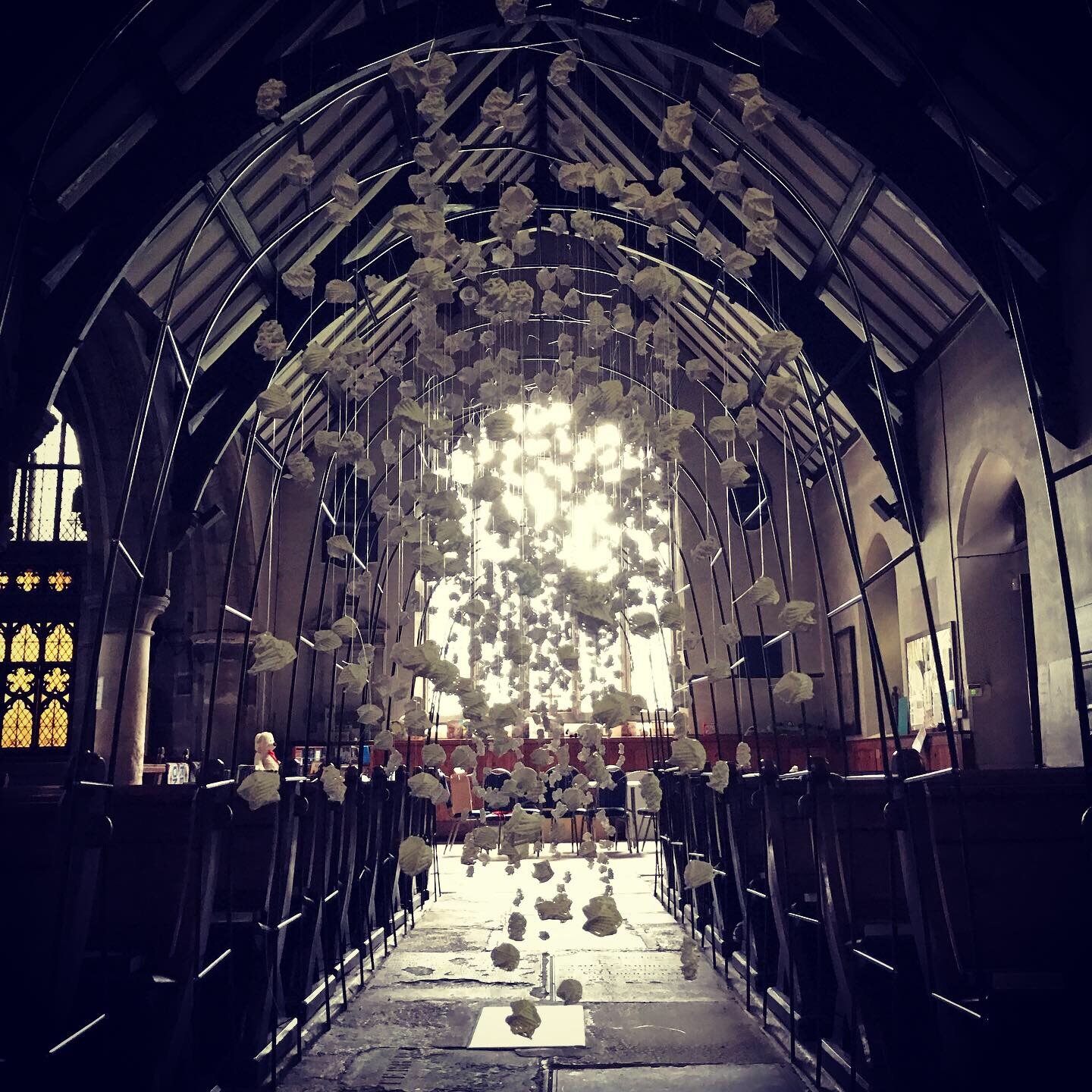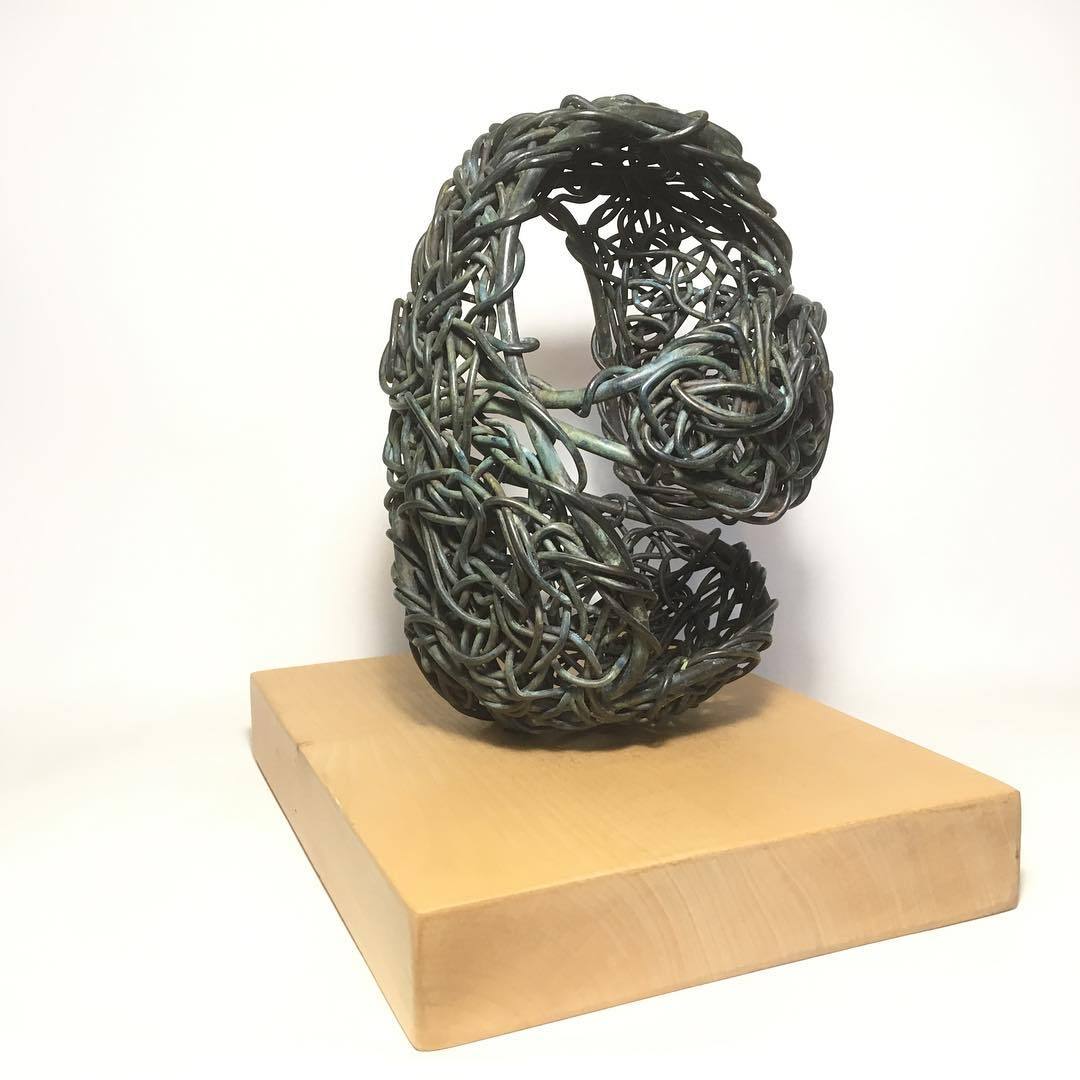Your Custom Text Here
Paper Murmuration
Rachel was commissioned by Platform Thirty One to create an art installation for this years Alfreton Festival, Derbyshire which took place on the 28th & 29th September.
The installation in St Martins Church was created from over 1000 individually woven paper units using the five stranded spiral corn dollie weave.
Over 1000 individually woven corn dollies create this paper installation
Art Fair East
Textured Bronzes and Crocheted Bronze sculptures ready for next weeks Art Fair East exhibition, I’ll be taking along these two collections plus a few more too #sculpture #artfaireastnorwich #artfaireast #Art #bronzesculptures
https://www.instagram.com/p/Bqie-K0g-av/?utm_source=ig_tumblr_share&igshid=1uf8e7x6dg6im
Exhibition of student work
ELYSE BENNETT - ‘BETWEEN’
The work consists of a number of plaster casts of varying shapes and sizes that are intended to represent the buildings in and around Derby city centre. The composition examines the spaces and layouts of the streets, as well as the feelings evoked when walking down a typical street within Derby. Based on local architecture, my work provides a fragmented reinterpretation of the city, creating a personal response to my surroundings.
The casts have found elements added within them, which make a direct connection to the site and the construction of the buildings: slate, stones, concrete, metal, steel rods and brick have been added to the casts.
I am inspired by architecture and the way simple forms interact to create a sense of space, a sense of something which isn’t necessarily seen, but felt. I consciously work with negative space as much as I do positive space, which I feel helps to inspire this feeling of presence within my work.
WEBSITE: http://elysebennettfineartblog.tumblr.com/
CONTACT: elyse.bennett11@hotmail.com
I visited the opening of the second year Fine Art students show this evening and particularly enjoyed this piece, a great show in a fantastic venue
Student Exhibition

‘Twelve’ is a selection of contemporary artworks created by 2nd Year BA Hons Fine Art students from the University of Derby. Ranging from paintings to sculpture to video work, there is something to suit all tastes and interests.
Unlike any of the previous exhibitions and shows held by University of Derby students, this year the pieces will be displayed in St Werburgh’s Church. Anybody is welcome to come and have a look around!
OPENING NIGHT
On Friday 22nd May there will be an opportunity for friends and family to have the first look at the pieces before the exhibition is opened up to the general public! This will be from 5pm until 7pm and refreshments will be available.
OPEN TO THE PUBLIC
The exhibition will be open to the public on Saturday 23rd May then all week from 25th May and there will be at least 2 of the artists in the Church at all times who will be happy to answer any questions or listen to any feedback!
Saturday 23rd May - 10am until 4pm
Monday 25th May - 10am until 4pm
Tuesday 26th May - 10am until 4pm
Wednesday 27th May - 10am until 4pm
Thursday 28th May - 10am until 7pm
Friday 29th May - 10am until 4pm
Looking forward to visiting the students to see some of their art on display.
Visitor responses
During this second artist residency I have been opening the doors to the Gothic Hall every day to allow the visitors to Elvaston Castle a glimpse inside the artist studio. I have been fascinated with the responses of the visitors whether it be a comment to each other or to their children, or a comment made directly to me.
Children seem naturally to be very inquisitive with every aspect of the artwork on show, I’ve overheard their “what is it?” questions to parents and carers and the response is fascinating. Answers have ranged from; “I don’t know, it’s art” to “these are artworks and they represent what the artist is feeling or experiencing” or they add “lets go find out”. The children and adults alike have seemed to be interested in what I have been creating or enjoy watching me as I carve into a block of plaster, they want to know why I am creating that shape, or what tools I am using or what is it going to be.
As a little experiment I have numbered all my plaster carvings from 1-13 and placed a note book and pen among them with a question “Which carving do you like and why”. Here are some of the responses, (you can look up the relevant carvings on earlier posts):
No 7. Looks like four crescent moons fused together
No 7 looks like a star
No 6 reminds me of an affectionate hug
No 7 reminds me of a crabs claws
No 5 Reflection of a natural form such as a fossil but equally of a millstone. The roundness of the sculpture is soft on the eye.
No 8 a big hug
No10 large nut
No 2 Earth like
No 6 Looks different from every view
No 6 I like it because its very smooth and pretty, also I like the shape of it
No 8 It reminds me of a child reaching up to hug an adult
No 6 Two swans whispering secrets
No 7 It looks like a dragon claw - raaaah!
No 1 Reminds me of a Yoga pose
No 6 Looks like Rams horns
No 2 I like the triangular outer form and the inner comma shape
No 5 Mill stone
No 13 Looks like Ghosts (Elliot aged 4)
No 7 It’s my favourite shape, its the best, it looks like bananas (Also Elliot aged 4 who spent a long time deliberating on his favourite)
No 7 It reminds me of claws
Such a wide variety of comments and I was surprised which shapes were being favourited, completely the opposite to my own preference. Some people said they were seeing female genitals which is interesting as many people saw male genitals in my older work. I don’t set out to make the female or male parts but the natural world is full of shapes that could be viewed as genitals.
Many visitors are drawn to touch the art, parents say to their children “don’t touch it’s art” or don’t bother saying anything and let their children do what they like, but most inform them to “ask the lady” and they are really happy when I point out a touching table. This table has resulted in some fascinating discussions with adults and children alike as they experience through their fingers.
It’s not just the children who want to touch, the plaster carvings seem to draw adults and every day they ask if they can touch, I always say yes. Whenever I visit a museum or gallery I often feel very frustrated at not being able to touch and experience the artwork through my fingers, so when there is the opportunity to touch I always do. It is such a pleasing sight to see some one enjoying touching your art work and getting joy from it.
Is the texture or surface of the sculpture as important as the look?
What are your own experiences ?
Plaster Carving Experiments - Part 2 Assessing the shapes
Some of the shapes I have recently carved in plaster may not be successful when weave is applied over the surface, any fine details in the carving will be lost and not transfer into bronze.
I think moving forward the shapes of the plaster need to be simple and smooth. If they feature any voids or holes the weave should be able to pass through without blocking the space completely. If it passes through and fills the gap would this create more interest when cast? or would this cause a problem for the foundry?
The finished plaster blocks that will go through to the casting stage need to be fitted with a metal rod, this is to make sure the block is held mid air and thus not crushing the wax weaving that will be applied later. Will a metal bar sticking out of the plaster block be a hinderance to my carving?
Fitting the metal rods inside the plaster blocks prior to carving may be tricky as they need to be inserted into the plaster whilst it is wet and not yet set. Possibly the rod should be inserted prior to vibration, but I need to think how the rod can be secured whilst being vibrated as this may create more problems.
Next step - make 5-6 blocks of fine casting plater, carve them and then weave onto them using cord to see how the weave works being applied to a solid. Potential problems could be; not be able to work the weaving on both sides, getting the weave tight enough that it does not sag away from the block and trying to retain the overall shape.








